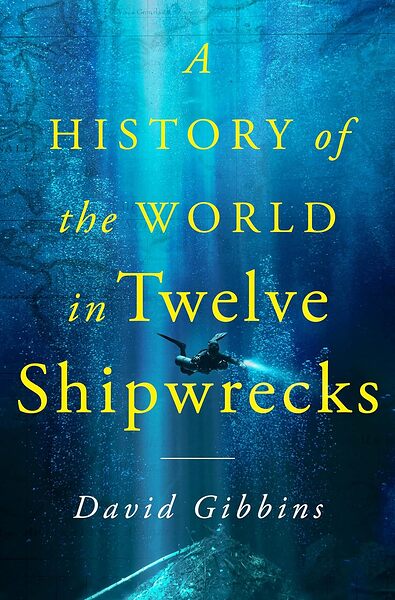Looking for a good read? Here is a recommendation. I have an unusual approach to reviewing books. I review books I feel merit a review. Each review is an opportunity to recommend a book. If I do not think a book is worth reading, I find another book to review. You do not have to agree with everything every author has written (I do not), but the fiction I review is entertaining (and often thought-provoking) and the non-fiction contain ideas worth reading.
Book Review
Sea Bottom Time Capsules
Reviewed by Mark Lardas
April, 7 2024
“A History of the World in Twelve Shipwrecks,” by David Gibbins, St. Martin’s Press, 2024, 304 pages, $32.00 (Hardcover), $15.99 (E-book), $20.89 (Audiobook) $45.95 (Audio CD)
Civilization is driven by commerce and technology. One feeds the other. Historically, much of that commerce has moved by sea. In turn, ships moving cargoes are influenced by their times’ technology. Historian Fernand Braudel called the sea “the greatest document of its past existence.”
“A History of the World in Twelve Shipwrecks,” by David Gibbins, shows how through marine archaeology the sea allows the world’s history to be read. He uses twelve wrecks as a springboard for looking at the state of the world when the ships sank.
He starts in prehistory examining a 2nd Millennium BC Bronze Age vessel. He finishes 4000 years later, looking at a 20th century steamer torpedoed and sunk during World War II. Along the way he stops at ten different places: Ancient Egypt, Greece and Rome, Byzantium, Tang China, the Viking Era, King Henry VIII’s England, the Dutch Golden Age, 18th century piracy, and 19th century exploration.
Each chapter uses a period wreck to examine the ship and the times which created it. Every shipwreck is a time capsule, preserving the history of the period it was built. It reveals goods traded, existing inventions, how people lived and their interests. Diet, living standards, education levels and religious beliefs are preserved in part by the sea, waiting to be uncovered.
This book is also a history of marine archaeology, a discipline which emerged in the last half of the 20th century. Gibbins explains how technologies like the aqualung and remote operating vehicles offered access to previously inaccessible wrecks starting in the 1960s. He describes the growth of underwater archaeology and the increasing sophistication of the technologies used to find and preserve artifacts on the sea bottom.
He also shows how and why wrecks offer special access to history. They sharply define a point in time, and reveal the lives of the individuals involved from a merchant in Tutankhamun’s time to a survivor of a torpedoed ship in the Atlantic.
For Gibbins a renowned underwater archaeologist this is intensely personal story. He participated in many of the expeditions to the wrecks highlighted in this book. He helped making the discoveries and interpreting results. The twelve wrecks explored are highlights of his career.
“A History of the World in Twelve Shipwrecks” is at once a history and an adventure tale. It brings the realities of the past to life, while illustrating the excitement resulting from uncovering it.
Mark Lardas, an engineer, freelance writer, historian, and model-maker, lives in League City. His website is marklardas.com.
